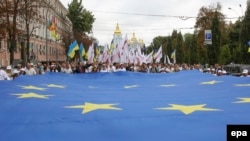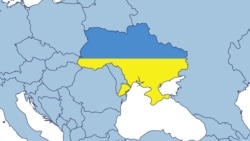Ukraine last week caused consternation in Brussels and beyond when it put the brakes on a key free-trade and political deal with the European Union and said it would try to revive economic ties with Russia instead. Protesters in Kyiv and other Ukrainian cities have taken to the streets to try and persuade President Viktor Yanukovych to change his mind and sign the Association Agreement at a summit in Vilnius this week. RFE/RL's Rikard Jozwiak takes a closer look at what the Association Agreement would entail.
What would Ukraine get from the Association Agreement?
The Association Agreement, including a Deep and Comprehensive Free Trade Agreement (DCFTA), would not mean a sudden, massive influx of EU cash into various sectors in Ukraine. The EU gave around 1 billion euros to Ukraine in grants in 2011-13 and will provide an additional 600 million euros if Kyiv strikes a deal on a $15 billion loan with the International Monetary Fund (IMF). But these sums lie outside the agreement.
What a treaty would do is to open the EU market to Ukrainian companies -- a market with 500 million consumers and a GDP of 12.9 trillion euros, representing about one fifth of the global economy. It's hard to measure how much exactly Kyiv would gain from the DCFTA, but some of the independent economic analysis that the EU has carried out suggest that Ukraine can expect a boost to its GDP of more than 6 percent over the next decade. The same studies also suggest that lower tariffs and increased competition would bring prices down, fueling an increase of household consumption of some 12 percent over 10 years.
What does the deal contain?
Under the agreement, Ukraine would adopt around 350 EU laws. Some of them concern environmental protection or road safety standards, but it is the trade-related legislation that would have the biggest economic impact. It is believed that Ukrainian exporters would save approximately 500 million euros of EU import duties almost immediately if the agreement were signed.
Ukraine has a slight advantage when it comes to import duties. That's because, under the agreement, the EU would open its markets to Ukrainian goods within seven years while Ukraine would have up to 10 years to open its market to European Union goods -- and up to 15 years for its car sector. The removal of EU import tariffs would be "front-loaded," meaning that most of the liberalization would occur in the first few years following the agreement's entry into force.
Take agricultural and industrial products, which make up a large chunk of EU-Ukraine trade. Under the DCFTA, the EU would immediately cut import tariffs on more than 80 percent of Ukrainian agricultural exports while Ukraine would do the same for only half of the agricultural goods coming from the EU. For industry, the figures are even more stark: The EU would immediately cut import tariffs on almost all Ukrainian industrial products, while Kyiv would do the same for less than half of the EU's industrial goods.
What are the other changes Ukraine would undergo?
The country would adopt some other laws that could give its economy a boost. For example, Ukraine would align its competition laws to those of the EU, meaning that cartels and monopolies, in theory, would be subject to effective legislation. Ukraine would also adopt a system of control of state aid similar to that of the EU, including an independent authority overseeing the practice. Both the EU and Ukraine would report annually the total amount, type, and distribution of subsidies. The rules on subsidies apply to all areas except agriculture and fisheries.
A trade-dispute settlement mechanism would also be set up. This would be based on the same model as the World Trade Organization (WTO) but could put stricter time limits on arbitration procedures, particularly those regarding urgent energy disputes.
Ukraine would adopt current and future EU legislation on public procurement. With the exception of defense procurement, Ukrainian service providers would have full access to the EU public-procurement market, which accounts for more than 2 trillion euros, or 16 percent of EU GDP.
Is Ukraine's Association Agreement different from the Association Agreements of countries from the Western Balkans?
In one sense they are similar in that the agreements give access to the EU markets and the countries have to adopt the necessary EU legislation. But the similarities stop there. The countries in the Western Balkans are assured that they one day will become EU member states. That means that they will have to copy all legislation. More money will also come their way. It is estimated that the EU will spend between five to 10 times more per head in, for example, Serbia than in Ukraine.
What would Ukraine get from the Association Agreement?
The Association Agreement, including a Deep and Comprehensive Free Trade Agreement (DCFTA), would not mean a sudden, massive influx of EU cash into various sectors in Ukraine. The EU gave around 1 billion euros to Ukraine in grants in 2011-13 and will provide an additional 600 million euros if Kyiv strikes a deal on a $15 billion loan with the International Monetary Fund (IMF). But these sums lie outside the agreement.
What a treaty would do is to open the EU market to Ukrainian companies -- a market with 500 million consumers and a GDP of 12.9 trillion euros, representing about one fifth of the global economy. It's hard to measure how much exactly Kyiv would gain from the DCFTA, but some of the independent economic analysis that the EU has carried out suggest that Ukraine can expect a boost to its GDP of more than 6 percent over the next decade. The same studies also suggest that lower tariffs and increased competition would bring prices down, fueling an increase of household consumption of some 12 percent over 10 years.
ALSO READ: Yanukovych Says Ukraine Will Wait For A Better EU Deal
What does the deal contain?
Under the agreement, Ukraine would adopt around 350 EU laws. Some of them concern environmental protection or road safety standards, but it is the trade-related legislation that would have the biggest economic impact. It is believed that Ukrainian exporters would save approximately 500 million euros of EU import duties almost immediately if the agreement were signed.
SPECIAL PAGE on the Third Eastern Partnership Summit in Vilnius
Ukraine has a slight advantage when it comes to import duties. That's because, under the agreement, the EU would open its markets to Ukrainian goods within seven years while Ukraine would have up to 10 years to open its market to European Union goods -- and up to 15 years for its car sector. The removal of EU import tariffs would be "front-loaded," meaning that most of the liberalization would occur in the first few years following the agreement's entry into force.
Take agricultural and industrial products, which make up a large chunk of EU-Ukraine trade. Under the DCFTA, the EU would immediately cut import tariffs on more than 80 percent of Ukrainian agricultural exports while Ukraine would do the same for only half of the agricultural goods coming from the EU. For industry, the figures are even more stark: The EU would immediately cut import tariffs on almost all Ukrainian industrial products, while Kyiv would do the same for less than half of the EU's industrial goods.
What are the other changes Ukraine would undergo?
The country would adopt some other laws that could give its economy a boost. For example, Ukraine would align its competition laws to those of the EU, meaning that cartels and monopolies, in theory, would be subject to effective legislation. Ukraine would also adopt a system of control of state aid similar to that of the EU, including an independent authority overseeing the practice. Both the EU and Ukraine would report annually the total amount, type, and distribution of subsidies. The rules on subsidies apply to all areas except agriculture and fisheries.
A trade-dispute settlement mechanism would also be set up. This would be based on the same model as the World Trade Organization (WTO) but could put stricter time limits on arbitration procedures, particularly those regarding urgent energy disputes.
RELATED: Is A New Orange Revolution Brewing In Ukraine?
Ukraine would adopt current and future EU legislation on public procurement. With the exception of defense procurement, Ukrainian service providers would have full access to the EU public-procurement market, which accounts for more than 2 trillion euros, or 16 percent of EU GDP.
Is Ukraine's Association Agreement different from the Association Agreements of countries from the Western Balkans?
In one sense they are similar in that the agreements give access to the EU markets and the countries have to adopt the necessary EU legislation. But the similarities stop there. The countries in the Western Balkans are assured that they one day will become EU member states. That means that they will have to copy all legislation. More money will also come their way. It is estimated that the EU will spend between five to 10 times more per head in, for example, Serbia than in Ukraine.








